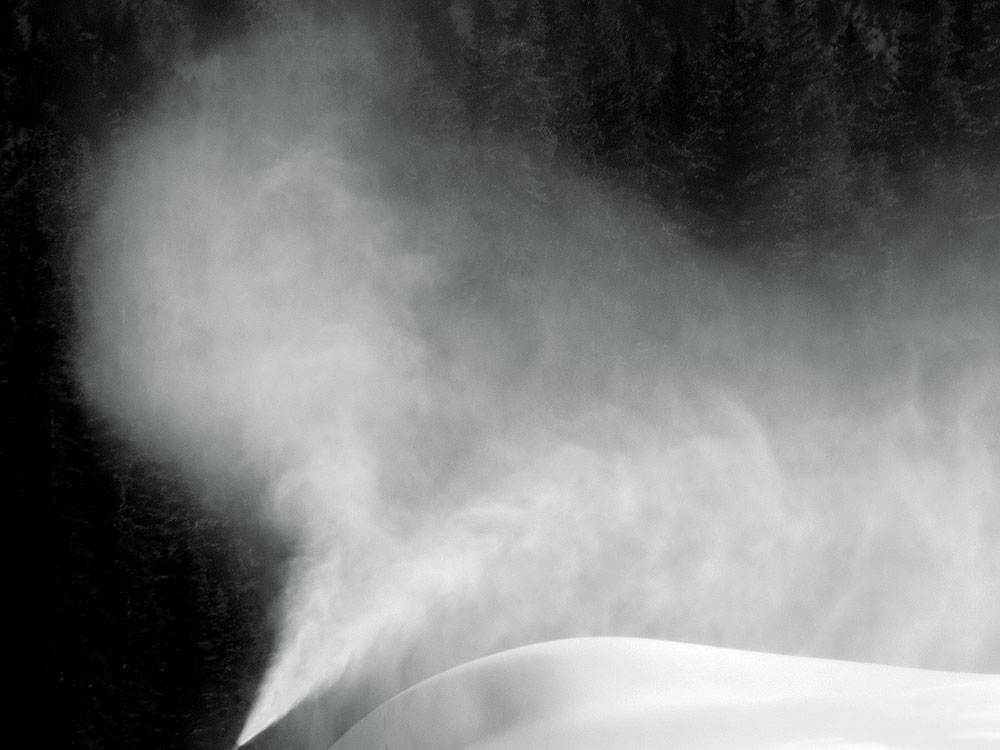

A lance-mounted snow gun makes snow on a windy day at Aspen Mountain, Colorado. A ‘whale,’ or pile of snow under the snow gun, can be seen at lower right. Photo by Bob Limacher, Aspen Skiing Company.
Like grow lights and center pivot irrigators, snowmakers are technological lynchpins of our economy. But what governs how snow’s made? And what are its impacts?
Our humidity is a major factor. If the air is dry enough, snow can actually be made at temperatures above freezing (32 degrees F). Just as evaporating sweat helps us cool down, when it’s dry, water droplets evaporate and cool as they’re ejected from snowmaking guns. Thus, in dry conditions, evaporative cooling lowers localized temperatures enough to freeze water droplets, even in temperatures up to 40 degrees F. Conversely, when air is moist, little evaporation occurs and lower ambient air temperatures are needed for ice crystals to form.
During snowmaking another type of cooling occurs—called expansive or adiabatic cooling. If you’ve ever felt how cold a can of compressed air gets after usage, you’ve experienced this effect. Such cooling occurs when compressed air shot out of a snow-gun expands as it’s released from the water nozzle. The expansion causes cooling, helping freeze the water droplets. This process can drop air temperatures nearly 100 degrees within inches of a snowmaker’s nozzle.
Many ski resorts have hundreds of snowmaking machines and a cornucopia of special nozzles to take advantage of these phenomena. They are used on the ground or mounted on towers, poles or lances. All rely on high water and air pressures to produce snow.
Manmade snow isn’t shaped like the delicate and pointy six-sided snowflakes that we all cut from folded paper as children. Rather, it is shaped like a sphere and is a denser, larger particle. Sometimes the cores of machine-made snowflakes aren’t totally frozen by the time they hit the ground, so the piles or “whales” of snow under snow-guns are allowed to cure for days until they’re “dozed into place.”
Whether it’s fresh or stale, artificial snow behaves quite differently than nature’s own. To skiers and boarders it feels more akin to sticky concrete than to fluffy champagne powder. That’s because it’s almost 30 percent ice and 70 percent air, compared to our best natural snow, which is about 10 percent ice and 90 percent air. On the upside, manmade snowflakes are more durable than nature’s own, so are ideal for establishing a base or creating jumps, pipes, and terrain parks.
All this snowmaking uses an incredible amount of energy. It takes megawatts to pump water uphill, to cool it before pumping it, to compress air, cool it, and to dehumidify it before sending it downpipe, and to install, maintain, and run all the associated equipment. With higher temperatures and higher humidity, the costs of snowmaking can more than double. Thus snowmaking technology has sought energy, climate, and timing efficiencies over the years. For example, nozzles have improved to the point where they make much smaller crystals with less air, which translates to more snow for the same amount of pumping energy. Today’s snow-guns use less than a third of the air they used a decade ago—an achievement given that compressing air uses more energy than pumping water. Some resorts store water in upslope ponds, which gravity then feeds into snowmaking lines, again saving pumping energy. Others have built bottom-of-mountain water storage ponds because pumping water great distances, like the miles and miles of pipe needed to get water to snow cannons, is expensive. In general, in
Colorado 20 percent more snow is made today, using 40 percent less energy than 10 years ago.
But what about the water? Most of it is purchased or taken from streams, rivers, and runoff. Like the Front Range’s “buy and dry” strategy for purchasing agricultural water, ski corporations have snapped up senior water rights to the tune of millions per year. Fortunately nearly 80 percent of this water gets returned to the system whence it came, with the remainder lost to evaporation. Some places even recapture their meltwater and reuse it. But the quantity, timing of diversion/return of this water has serious impacts on the quality of water and scope of downstream watersheds.
And the future? As our planet warms, ski seasons will have warmer average low temperatures, they’ll be shorter, and their shoulders will be less predictable because spring storms will more frequently bring rainfall or freezing rain than light, fluffy snow. Thus, snowmaking will become even more important, despite the fact that the energy byproducts from installing, maintaining and operating snowmakers cause global warming.
Notwithstanding these issues, plan on seeing more snowmaking. It feeds our economic engine, it’s improving in efficiency while reducing its environmental impact, and over the long haul, is more predictable than the cloud-seeding strategies invested in by our skiing and agriculture industries.
James Hagadorn, Ph.D., is a scientist at the Denver Museum of Nature & Science. Suggestions and comments are welcome at jwhagadorn@dmns.org.




0 Comments